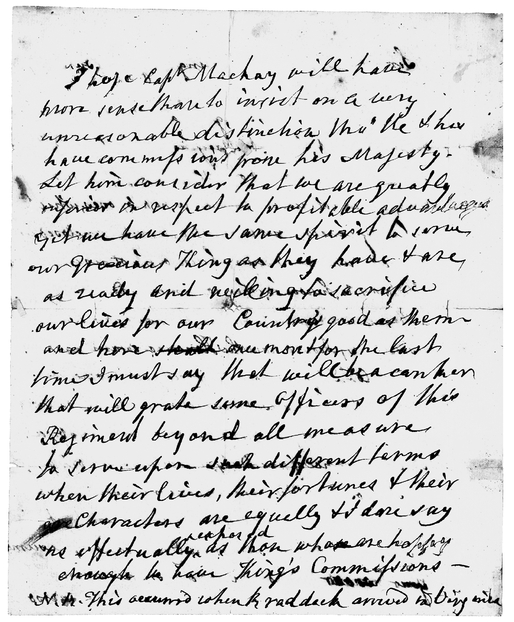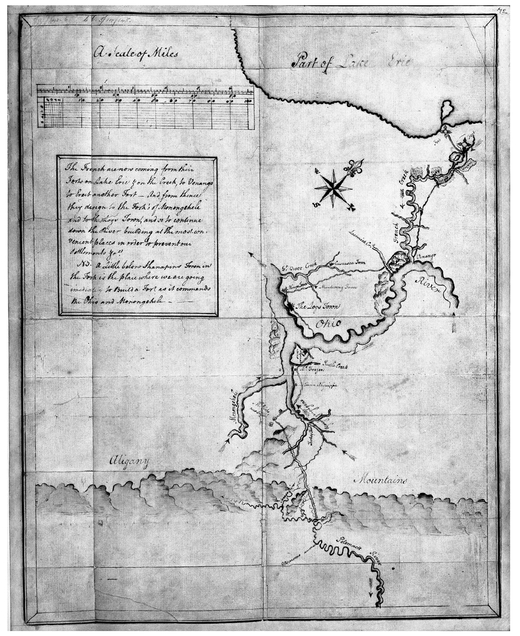CHAPTER FOUR
“Thou Art Not Yet Dead, My Father”
To Robert Dinwiddie in the Governor’s Palace at Williamsburg, the news that the French were building the first three forts—Presque Isle, Le Boeuf, and Machault—in the summer of 1753 looked unmistakably like an attempt to prevent Virginia from expanding settlement within its legitimate boundaries. Dinwiddie accordingly informed the duke of Newcastle and other leaders of His Majesty’s government of what he characterized as a brazen French attempt to seize lands that belonged by right of ancient claim to the king of Great Britain. The ministers found the news deeply troubling. The last war with France had ended only five years before, and France had emerged from it in a far stronger position than Britain. Apart from the taking of Louisbourg, the British had won no victories. Desperate for peace in 1748, Britain had essentially forced its ally Austria to sign a treaty that surrendered the rich province of Silesia to France’s ally, Prussia. Bad feelings between the Austrians and the British had persisted. Were the French even now moving toward another war, to take advantage of the weakened Anglo-Austrian alliance? Fearful of this possibility, the ministers concluded that only a forceful response would deter the French from whatever devious and subtle plan they were pursuing in North America.
The cabinet therefore sent a circular letter to Dinwiddie and his fellow governors authorizing them to remove the French from any “encroachments” they had made on the frontiers of their colonies. Since Dinwiddie’s case had pertained most directly to Virginia’s frontiers, he received a separate, more detailed set of instructions outlining the actions he was to take. First, he was to demand that the French withdraw from the posts they had built. Second, he was authorized to erect “forts within the king’s own territory” and “to repel force with force” should the French seek to eject Virginia’s troops from them. Finally, if the French refused to leave forts they had built within “the undoubted limits of His Majesty’s dominions,” Dinwiddie was authorized “to enforce by arms (if necessary)” their evacuation. Cannon and ammunition were sent to help him arm and defend whatever forts he needed to build on Virginia’s frontier.
The officers of the crown, in effect, gave Dinwiddie all the authority and armaments he needed to build a fort at the Forks of the Ohio. Had he been on good terms with the House of Burgesses at the time his instructions arrived, and had the members of the House not had excellent reason to suspect that he planned to promote the fortunes of the Ohio Company at public expense, Dinwiddie might have mustered the support he would have needed to build a fort without delay. Ever the stickler for collecting every penny due to him, however, the governor had lately antagonized the legislators in a dispute over the terms of his compensation, creating a legislative impasse. Until the dispute could be sorted out by authorities in England, all that Dinwiddie could do about the French was to send an emissary out to demand that they leave the posts they had recently completed. The man the governor chose to carry the message was George Washington.
Why the governor picked a twenty-one-year-old major of the Virginia militia for this mission—a man who spoke no French, had little formal education, and utterly lacked diplomatic experience—may not seem intuitively obvious. Young Washington, however, had several qualifications. He had the backing of Lord Thomas Fairfax, who approved of the work Washington had done for him as a surveyor; he had an intense ambition to prove himself worthy of public trust and thus to rise in the ranks of the planter gentry; and he had both the willingness and the hardihood to undertake a five-hundred-mile journey under miserable conditions, in the late fall and winter of the year. Moreover, Washington had a powerful personal desire to see the Ohio country. His late half brother, Lawrence, had been one of the original shareholders in the Ohio Company. While Washington himself did not hold stock in it, his experiences as a surveyor on Fairfax lands in the Shenandoah Valley had convinced him that his future fortunes would be tied to the development of the West.
Major Washington left Williamsburg on November 1, 1753, with little idea of what lay ahead. Luckily he had Christopher Gist, who knew the Ohio Indians and the region they lived in as well as anyone in Virginia, to accompany him as a guide, translator, and negotiator. Luckily, indeed, for Gist also had the strength and presence of mind to save Washington’s life on two occasions on the journey, thus allowing the major to return to Williamsburg in mid-January 1754 and report what he had seen to Dinwiddie. The French, Washington explained, were well established on the Allegheny. He had visited forts Machault and Le Boeuf; both were sturdy and well supplied. At Fort Le Boeuf he had found the regional commander, Captain Jacques Legardeur de Saint-Pierre of the troupes de la marine, and delivered Dinwiddie’s message to him. That veteran soldier, who had seen service at posts from Nova Scotia to Lake Winnipeg to Tennessee, had politely declined to leave; the decision, he explained, was not his to make. Moreover, Washington had seen canoes and bateaux on the banks of the river and in the woods near Fort Le Boeuf, hundreds of them: a clear indication that the next stage of the French occupation would be to build a fourth fort, at the Forks of the Ohio, in the coming year.
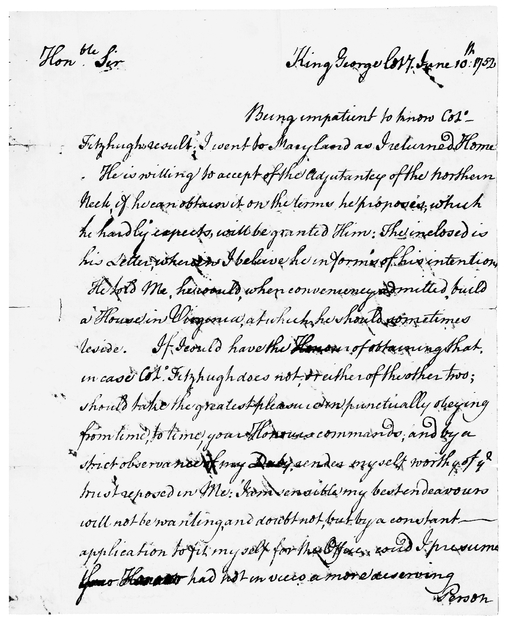
Washington’s letter to Dinwiddie, June 10, 1752. This letter from George Washington requesting a militia appointment from Lieutenant Governor Dinwiddie marks the beginning of the young Virginian’s military career. Enjoying the support of Lord
Thomas Fairfax and other members of the governor’s council, Washington was appointed adjutant of Virginia’s southern militia district in December. (Courtesy George Washington’s Fredericksburg Foundation)
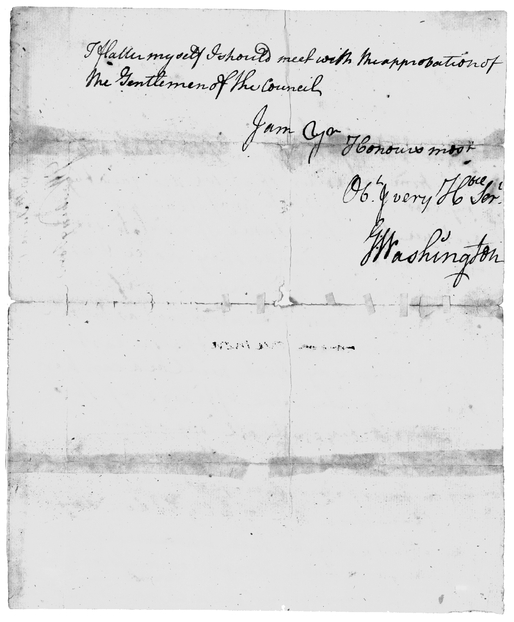
The single most alarming thing about Washington’s report, ironically, was a fact that seems not to have greatly concerned either him or the governor: although Tanaghrisson had accompanied Washington’s party to Fort Le Boeuf, he was able to persuade only one Mingo war chief, Guyasutha, and two other Mingo warriors to make the journey with them. Had Washington known more of Indian diplomacy, he would have found cause for worry in such a small escort and especially in the complete absence of Delawares and Shawnees from the Half King’s entourage. Legardeur de Saint-Pierre, vastly more experienced in such matters, understood precisely what it meant: whatever Tanaghrisson might say, the Ohio Indians were unwilling to commit themselves to an alliance with the British. The Half King clearly had only slender support among the people he was supposed to lead. If the French could beat the English to the Forks in the spring, they would meet no effective resistance from the natives.
Dinwiddie quickly dispatched a copy of Washington’s journal to the duke of Newcastle and other British authorities, who agreed that the governor should build a fort at the Forks as quickly as possible and recruit a Virginia provincial regiment to defend it. He had a harder time persuading the members of the House of Burgesses, but in the end they appropriated £10,000 to pay for the fort and two hundred soldiers. Neither the amount of money nor the number of men was adequate, but they gave Dinwiddie what he needed to proceed. Later he would ask for supplementary funds and men, and the burgesses, grudgingly, would comply.
Washington, who now knew the upper Ohio region better than any other qualified officer, asked to be appointed as the regiment’s lieutenant colonel. Dinwiddie gladly agreed, and issued the necessary orders to allow him to enlist men for the unit. The governor also issued commissions appointing several Pennsylvania traders who had taken refuge at Red Stone Fort as officers in the Virginia militia; they were to raise a company of carpenters and begin building a fort at the Forks as soon as possible.
Washington’s map of the Ohio River region, 1754. Major Washington turned a trained surveyor’s eye to the landscape during his arduous journey westward from the Ohio Company storehouse at Wills Creek on the Potomac River to the French posts in the upper Ohio Valley. His journal and testimony, together with this manuscript map of the region, convinced Dinwiddie and his council of the need to counter the French encroachments. (The National Archives of the UK [PRO])
The new lieutenant colonel had a terrible time convincing men to volunteer. In large part this was because the skinflint burgesses had approved a daily wage for the common soldiers that was less than half of what a common laborer could earn, a paltry sum that was to be supplemented by a modest grant of land to be awarded at the end of service. By mid-April, when Washington marched the unit west toward Wills Creek, he had only 159 soldiers under his command. They were far from a promising lot. Many were paupers and vagabonds who had been coerced into service. The regiment as a whole was poorly clad, poorly shod, poorly supplied, and as yet wholly untrained.
Washington cut a more dashing figure than his men, but did not know a great deal more about what he was doing than they did. All that he understood of military service he had learned from reading books and quizzing his older half brother, Lawrence, who had once held a captain’s commission in the British army. This did not particularly concern him, because he was accustomed to learning by experience, and therefore eagerly anticipated the arrival of the regiment’s commanding officer, Colonel Joshua Frye, whom he expected to supply the expertise he lacked. Frye was to bring more troops and supplies to a rendezvous with Washington at the Wills Creek fort; in addition, Washington knew, the Virginia Regiment would be joined by a company of British regulars from South Carolina. Once the reinforcements arrived and the men had been drilled enough to know their duty, they would march for the Ohio and defend the new post at the Forks. Fort Prince George, named for the heir apparent to the throne, would (Washington believed) stand up to attack if the French were to be so foolish as to try to eject the Virginians from the Forks. That, at least, was the plan.
Washington had been at Wills Creek only a couple of days when on April 22 the commander of the carpenters’ company arrived to inform him that hundreds of French troops had appeared on the Allegheny in a flotilla of canoes and bateaux on April 17, carrying with them no fewer than eighteen cannon. With his forty men desperately short of food, arms, and ammunition, he had taken one look at what seemed to be a thousand Canadians and surrendered the recently completed stockade. Washington absorbed the news, took stock of his own underequipped and untrained men, wrote the necessary reports to Dinwiddie, and ordered the regiment to make ready to march. Despite the unpromising state of his command and his own lack of experience, he intended to comply with Dinwiddie’s orders to “make prisoners of or kill and destroy” any “Offenders” against the king’s authority who had sought to “obstruct the works” at Fort Prince George. He would move his force to Red Stone Fort and wait for Frye and his reinforcements there; then they could take back the Forks.
The regiment marched from Wills Creek on April 30. By May 24, it had built a crude wagon road over fifty of the eighty miles that separated Wills Creek from Red Stone Fort, and encamped in a valley between two formidable mountains, Chestnut Ridge and Laurel Hill. The spot, called Great Meadows, was a quarter-mile wide, rather boggy, grassland perhaps a mile in length with a creek meandering down its center. Washington saw what it had to offer—fodder for his draft animals and a constant supply of water—and decided that it would be a useful way station. He ordered a pause for his men to clear brush, cut fodder, and construct a storehouse.
On the morning of May 27, Christopher Gist rode into camp to tell Washington that a party of French soldiers had passed his trading post at noon on the previous day. He estimated that they were now within five miles of the Great Meadows. Washington, fearing an attack, sent half his men west toward the Monongahela to look for them. At sunset, a Mingo warrior arrived in camp with a message from Tanaghrisson saying that the French had bivouacked about seven miles to the north. Only then did Washington understand that he had sent his men in the wrong direction. Hurriedly he gathered up half of his remaining troops and led them off, behind the Indian guide, for Tanaghrisson’s camp. All that night the Virginians blundered through the woods in a heavy rain, arriving at the Indian camp around sunrise. Tanaghrisson and the handful of warriors he had with him offered to lead Washington and his wet, weary men to the French camp, which was not far off.
When they arrived at the top of a rock wall overlooking a small glen, Washington saw that the French were just crawling out of their bark shelters and beginning to prepare their breakfast. He quietly arrayed his men above the hollow. Tanaghrisson and his warriors slipped off below to block the escape route.
The shooting that broke out soon thereafter may have started (as Washington maintained) when the French, suddenly seeing men on the rocks above them, seized their muskets and fired; or it may have begun (as the French attested) when the English unleashed a volley at them without warning. At any rate the confused firefight soon ended when the French officer in charge, wounded, called out for a cease-fire. One Virginian was dead, and three wounded; the French had suffered fourteen casualties among the thirty-five men in the camp.
The French commander, a thirty-five-year-old ensign in the troupes de la marine named Joseph Coulon de Villiers de Jumonville, was among the wounded. Now, through an interpreter, he tried to explain his mission to Washington. He had been sent by the commandant of the new fort at the Forks, Fort Duquesne, on a diplomatic mission: he was to deliver a letter to Washington ordering him to evacuate the lands of the king of France or suffer the consequences. The translation of the letter was proceeding when Tanaghrisson stepped up to Jumonville, raised his hatchet, and smashed open the ensign’s skull. His warriors then began to kill the rest of the wounded, scalping and stripping them of arms and clothing. By the time Washington gathered enough of his wits to intervene, only one of the wounded men was left alive.
Why had it happened? Washington himself could scarcely have fathomed the reason at that moment, but the words that Tanaghrisson spoke to Jumonville immediately before he killed him made it clear: “Tu n’es pas encore mort, mon père”—“Thou art not yet dead, my father.” When he called Jumonville “father,” Tanaghrisson evoked the role that representatives of the French king had traditionally claimed in alliances with native people; then he denied the power of that name by killing the man who bore it. Tanaghrisson had committed a murder, but he had also made a diplomatic statement. He was declaring war—on his own behalf and that of the Virginians.
Tanaghrisson committed this horrible, desperate, calculated act for a reason that would have been apparent to Washington if only the Virginian had known how to interpret what he had earlier seen at the Indian camp. The Half King had perhaps eighty people with him. At most a dozen were warriors; the rest were women, children, and old men. All, or virtually all, of them were Mingos. It was, in other words, a refugee group, driven from the Forks by the loss of Tanaghrisson’s status as a leader. The Delawares, Shawnees, and hundreds of remaining Mingos were—had to be—dealing directly with the French. Tanaghrisson’s only hope of restoring his own position, and the influence of the Iroquois League, was to return to the valley with a powerful ally. Jumonville’s blood had sealed what the Half King intended to be an unbreakable covenant with Washington and the Virginians, and through them with the king of England.
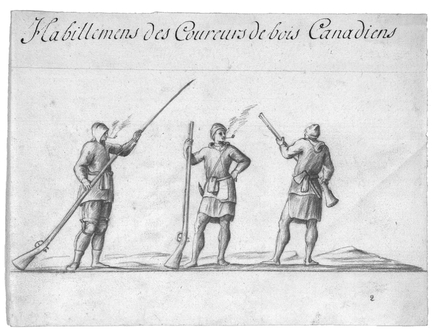
“Habillemens des Coureurs de bois Canadiens,” no. 2. This rare eighteenth-century sketch illustrates the common working dress of Canadians engaged in war and the fur trade, which borrowed heavily from American Indian fashion. Ensign Jumonville’s party was composed almost entirely of such men, whose lack of military uniforms probably exacerbated the confusion of the skirmish with Washington’s Virginians on May 28, 1754. (Yale Collection of Western Americana, Beinecke Rare Book and Manuscript Library)
Washington, confused, tried to cover up what had been at the least a colossal humiliation by writing misleading reports of the action and sending them back to Dinwiddie along with the twenty-one Canadian militiamen who had survived. The Canadians, he cautioned, were spies. Nothing they might say about being on a diplomatic mission should be believed.
The massacre took place on May 28; the reckoning came five weeks later. In the interim, Washington learned by a letter from the governor that Colonel Frye had fallen from his horse and died; Dinwiddie had promoted Washington to the rank of colonel and commandant of the regiment. Two hundred more troops had arrived at Great Meadows from Virginia, hauling light artillery. Shortly thereafter the British regular infantry company from South Carolina had reached the camp, bringing forty beef cattle with them. Word had come that a great supply train was on its way; and Tanaghrisson, who moved his encampment to Great Meadows, professed confidence that the Ohio Indians would join the British if only Washington showed resolve. In view of these developments, Washington decided to attack Fort Duquesne.
It was a move that only a neophyte would have made, and it ended in a fiasco. An attempt to move men and supplies forward reached Gist’s Plantation only on June 18, when the Delaware chief Shingas, together with Shawnee and Mingo leaders from the valley, appeared to confer with Washington and Tanaghrisson. Three days of negotiations revealed that the Ohio Indians had no intention of joining in an attack on the French. This ended Tanaghrisson’s hopes of reestablishing himself, and Iroquois authority, on the Ohio. Knowing that the French would retaliate, he returned to Great Meadows, gathered his followers, and moved them a hundred miles east to take refuge at George Croghan’s trading post on Aughwick Creek. The Half King understood perfectly well that the fort that Washington had built—a small circular stockade around the storehouse that Washington had named Fort Necessity, which Tanaghrisson called “that little thing upon the Meadow”—was useless. If Washington had chosen to doom himself and his command, Tanaghrisson saw no reason that he, his family, and his followers should share their fate.
Incredibly, despite the departure of Tanaghrisson and the knowledge that the Ohio Indians would not help him, Washington tried to move ahead toward Red Stone Fort; Indian aid or no, he intended to attack Fort Duquesne. His resolve lasted until June 28, when Scarouady, an Oneida leader who had remained on the Ohio and who had perforce become Tanaghrisson’s successor as representative of the Iroquois League, arrived at Red Stone. A large French and Indian reinforcement had reached Fort Duquesne, he informed Washington, and a detachment was preparing to march against him. Washington’s fellow officers urged him to return to Fort Necessity. He agreed.
The retreat, a two-day forced march, left Washington’s men exhausted. They did what they could to strengthen their position, digging trenches outside the palisade of Fort Necessity to afford some shelter when the attack came. The stockade was too small to protect more than sixty or seventy men, and more than that many were too sick and weak to fight. That night it began to rain. The morning light of July 3 showed the trenches filling with water. Roll call disclosed that only three hundred of the four hundred men at the fort were fit for duty.
At eleven o’clock the French appeared—six hundred regulars and Canadian militiamen, together with a hundred Indian warriors, primarily Ottawas, Nipissings, and other allies from the Great Lakes—and launched their attack. Within minutes they had taken positions under cover on the wooded hillside that overlooked the fort, firing down on the men who huddled in the sodden trenches. The canopy of leaves above them enabled the attackers to keep their powder dry, and their muskets operable, for a long day of slaughter. The defenders, by contrast, quickly lost the capacity to fire back, and became little more than targets. By nightfall thirty of them were dead and another seventy had been badly wounded. The demoralized survivors, knowing how little chance they stood if the French and Indians renewed their attack the following morning, broke into the rum supply. Any sense of order and subordination that had survived the hellish day now fell to pieces; Washington contemplated the utter humiliation of a defeat that might well end in the annihilation of his command. Then something that seemed miraculous happened: the French ordered a cease-fire and proposed a parley on terms of capitulation.
The French commander, who happened to be Captain Louis Coulon de Villiers, Ensign Jumonville’s older brother, had more reason to be merciful than Washington knew. His men had come lightly armed and with only the ammunition they could carry; the long day’s firing had used up most of what they had. As a professional officer, he was concerned about the extent of his legal authority over the defeated force; unlike the amateur Washington, who in his ignorance had sent twenty-one Canadian militiamen to Williamsburg, de Villiers knew that in the absence of a state of war he had no authority to make anyone a prisoner of war. Even if he had wanted to consider the Virginians as criminals, there was no place to hold them at Fort Duquesne, and no way to transport them to Canada for trial. Moreover, he had come on a punitive expedition, and clearly had accomplished his mission of chastisement. He therefore offered the Virginians the conventional military compliment of a surrender “with the honors of war,” which allowed the defeated soldiers to keep their arms, colors, personal property, and one symbolic piece of light artillery. All that Washington had to do was to sign articles of capitulation and adhere to the conditions they stipulated: the Virginians would return the prisoners taken from Jumonville’s detachment, leave the Ohio watershed immediately and not return for at least a year, and leave two officers with the French as hostages, to ensure compliance with the surrender terms.
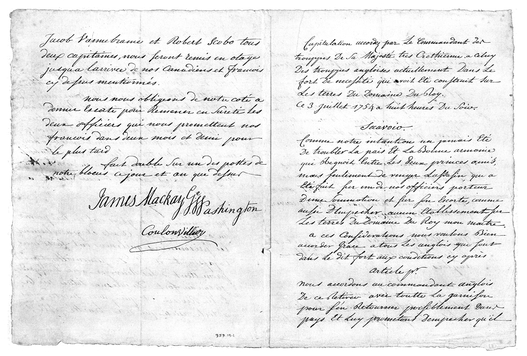
Document of capitulation at Fort Necessity (first and last pages). Lieutenant Colonel George Washington, Captain James Mackay, and the French commander Captain Louis Coulon de Villiers (Ensign Jumonville’s brother) signed this capitulation at eight in the evening on July 3, 1754. Washington was humiliated to learn later that the document twice referred to his “assassination” of Jumonville; he blamed Captain Jacob Van Braam, his subordinate, for making an incompetent translation. (With permission of the Royal Ontario Museum © ROM)
Washington signed. He did not know that the pages to which he set his name admitted that he and his men were responsible for “l’assassinat du S[ieu]r de Jumonville”—Jumonville’s assassination. Nor did he understand that elsewhere in the document de Villiers described Jumonville as “nos officier porteur d’une sommation . . . d’empecher aucun Etablissement sur les terres du domaine du Roy mon maitre”—“our officer carrying a summons . . . to prevent any establishment [of British occupation] on the lands of the King my master.”
To assassinate a diplomatic envoy was, under the eighteenth-century law of nations, an act of war. Months later the French government published the surrender document together with a translation of Washington’s personal journal, which de Villiers’s men found in the shambles of the Virginian camp. Only then would the king and his ministers understand that George Washington had done much more than simply fail to eject the French from the Forks of the Ohio. He had handed Louis XV all the justification he would ever need to declare war on Great Britain.


